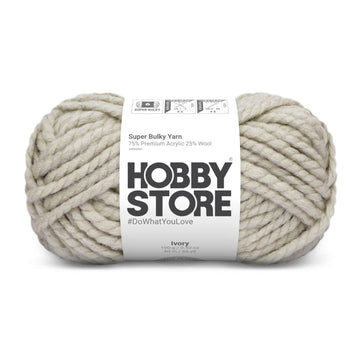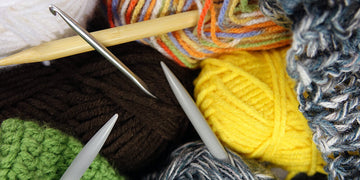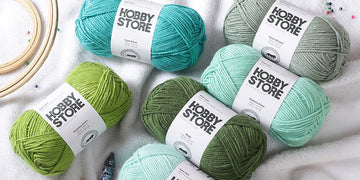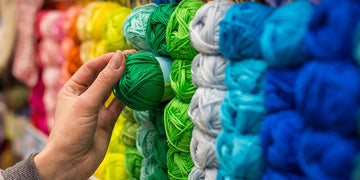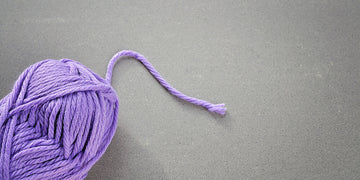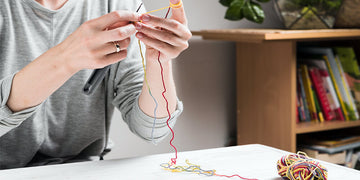What determines yarn weight?
Measurement of a yarn's diameter, or thickness, determines its weight. However, not every yarn will have the same thickness, hence they are grouped into yarn weight categories. The thickness is affected by a number of factors, including the thickness of the individual ply, the number of ply, the spinning twist, and the waviness or crimp of the fibres. The crimp in the fibres makes the yarn soft and springy to touch. It also adds bulk and traps a large volume of air between the fibres. Fibres with more crimp create fabrics that drape better than coarse fibres.One more factor that could make the yarn look thicker is the hairiness of the yarn. Basically, hairiness is the amount and length of fibre ends protruding from the body of the yarn. It's commonly confused with pilling, but pilling is totally different. Pilling occurs over time when the fibers on the outer surface of your yarn begin to loose their binding to one another. Those broken fibres on the surface tangle together, forming the characteristic lint balls called pills. The friction between your clothes and a backpack, purse, or even moving around on the couch can cause pilling.
Yarn Weight Categories - What are they?
◼ Craft Yarn Council (CYC) guidelines make it easy for yarn manufacturers to categorize their yarns for crafters. CYC has seven categories such as lace, fingering, sport, DK, worsted, bulky, and super bulky, which give an indication of yarn thickness and are numbered from 0-7. Lower numbers indicate lighter yarns, while higher numbers indicate heavier yarns. Check out our post on ◼ Yarn, Yarn Weight & Related Needle / Hook Sizes for more information.Yarn Weight - Why does it matter?
You can sometimes get away with not worrying about gauge or yarn weight. A few inches bigger or smaller will probably not affect the functionality of some projects, such as blankets, scarves, and hot pads. Making other items, such as socks and sweaters, requires precise measurements. Having spent hours making a beautiful piece of clothing and it not fitting is a nightmare! To meet gauge on projects like these, you'll need the correct yarn weight and needle/hook size.Imagine you're knitting or crocheting a 1-inch square. A chunky yarn may only require 3 or 4 stitches to measure 1 inch. If you're using a very thin yarn, you may need 8 or 9 stitches to measure 1 inch. To avoid this problem, it's always a good idea to check a pattern's suggested yarn weight and make a gauge swatch first.
The weight of the yarn is also important when you're making multiples. If you are making squares for an Afghan blanket, every square must be the same size, no matter what yarn you use. It is important to understand yarn weights to ensure consistency.
The easiest way to compare yarns with the same fibres and characteristics is to measure them physically if you are in a craft store. You should use the same type of fibre when substituting yarns.
Furthermore, if a yarn falls into one weight category, it does not necessarily mean that the other yarns in the same category will be the same thickness. Rather than being absolute numbers, yarn weights are ranges. For grouping different yarns, weight categories are extremely helpful. In fact, even within a weight category, there can be significant variations.
What are the ways to gauge yarn thickness?
-
Yarn Label
Reputed brands do mention the weight symbol and swatch with the recommended needle hook/size, you can gauge well with this information. However, keep in mind that yarn manufacturers may use different standards to classify their yarn. But if the information is not available, there are several other methods used to measure yarn thickness.
-
Ply
It's a common misconception that the higher the ply, the thicker the yarn. But that is not the case, check our post ◼ Yarn Ply Is Not Same As Yarn Thickness for more information.
-
Yardage
The more yarn in a skein, the thinner the yarn. Cotton typically weighs more than acrylic or polyester, however, so this method is not accurate.
-
NM/NE count
The length of yarn in meters of one gram of yarn or length of yarn in kilometers of one kilogram of yarn is called New Metric count (NM). The number of hanks (skeins) having length of 840 yards in one pound yarn is called New English count (NE).
Note: Yardage and NM/ME count are most used by yarn manufacturers and not very popular with crafters.
-
Comparing thickness
Even though it's not an absolute measure, it's worth a try especially if you've got something you've used before to compare it with. It's something a lot of our customers do e.g. fuzzy yarns may seem thicker, so they like seeing the yarn in person. It's okay to try this method, if it's your last resort.
-
WPI
Wraps Per Inch, this is becoming increasingly popular, because it’s very quick. It is calculated by wrapping a length of yarn around a ruler or an object such as a pencil, or something which has consistent circumference, and counting the number of wraps that fit within one inch.
It should be snug, and the wraps should lay side by side without overlapping or large gaps between them. Make sure you don't pull the yarn too tightly to avoid skewing the measurements. If you're not sure of your tension, practice with a yarn you know the weight of. Wrap the yarn until it covers one inch of the tool. After you have finished wrapping, count how many wraps fit into an inch.
Make sure to wrap the yarn twice, once loosely and once tightly, making sure both times there is no space between the wraps. Each time you wrap, count how many wraps fit within one inch and find the average. By comparing your WPI number to the weight category, you can determine the weight of your yarn and the hook or needle needed to reach a standard size gauge.
◼ Here's a quick comparison of WPI counts across a few websites and also video on ◼ How to determine yarn weight using wraps per inch (WPI).
Tip: Keep in mind that your results will vary depending on how tightly you wrap the yarn. To ensure an accurate gauge when working on any project, it is always wise to work up a gauge swatch first.
-
Knitting / Crochet Gauge or Swatch
Knitting and crochet gauge, also known as a swatch, refers to the number of stitches and rows in a particular pattern that can be produced using a particular type of yarn and a specific set of knitting or crochet needles. Gauge is important because it determines the finished size of a knitted or crocheted project. If a knitter or crocheter's gauge is different from the pattern's gauge, the finished project may be too small or too large, and the final measurements may not be accurate.
Which method is recommended?
I work with several crafters who make a living replicating my designs so we can sell them on marketplaces. I have learned – that what makes handmade products unique is that they are not machine-made! Hence, every product is not an exact replica of the original design. Reason - The same yarn, the same hook, but a different crafter will produce a different and unique result. Even if one crafter makes the same design over and over again, the result will not be exactly the same! When my crafters replicate my designs, I have to adjust the hook or needle size by up to +-1 mm to fit their knitting/crochet tension so the final project is of the same size.There are high chances that the WPI or the gauge swatch and the recommended hook/needle size may not match as per your experience with the yarn. Since every individual’s knitting / crochet tension is different. That’s why the best determining factor, is to make a gauge swatch yourself.
Among all the methods listed above, I think making a swatch yourself is the only way to accurately determine the yarn's suitability to your project. Your knitting/crochet tension is what determines everything, even if a designer has mentioned all the details, such as WPI, Standard Gauge, and Swatch on the label.
However, what if you're in a craft store or ordering online and can't unravel the yarn to check its WPI or knit a gauge swatch? And if you are unsure about which method to use, you can always ask for advice from other crafters or consult with the yarn shop's or online retailer's customer care.
Asking for help will save you both time and money. Having to unravel your project because the yarn didn't fit the measurements would have wasted your time, effort. Save money by buying only one hank/skein for your swatch, labeling it, and keeping it. If you need more, buy more. Otherwise, keep it for later, yarn never goes waste :)
Related Useful Links
◼ Choosing The Right Yarn For Your Project◼ Yarn, Yarn Weight & Related Needle / Hook Sizes




